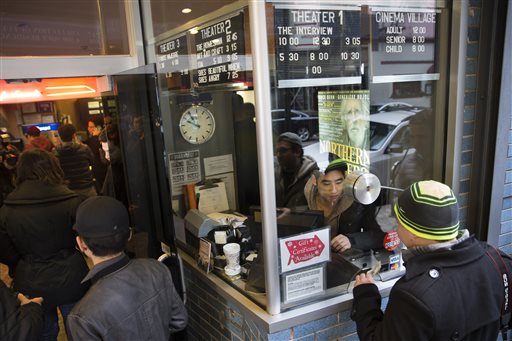
Patrons buy tickets at the Cinema Village movie theater box office in this Dec. 25, 2014, photo in New York. AP FILE
LOS ANGELES, United States — As Hollywood prepares to celebrate its achievements at the Golden Globes on Sunday, new figures show all might not be well in the film industry, with attendances at a quarter-century low.
The last 12 months have seen huge successes, with “Star Wars: The Last Jedi” and “Beauty and the Beast” raking in more than half a billion dollars each at home.
“Wonder Woman” and several Marvel superhero movies including “Guardians of the Galaxy Vol. 2″ and “Thor: Ragnarok” also have more than pulled their weight.
But the handful of hits has masked a decline of almost six percent on the year to 1.2 billion tickets sold, the lowest total since 1992, according to Box Office Mojo.
It’s all a stark contrast to the heyday of 2002, the busiest year since annual totals were first counted in 1980, when moviegoers bought 337 million more tickets than they did last year.
The cash registers are still ringing, with total domestic gross a shade over $11 billion in 2017 — boosted by outsize contributions in December from the eighth “Star Wars” installment and comedy reboot “Jumanji: Welcome to the Jungle.”
That’s only a small drop from the 2016 record of $11.4 billion; generally for the past five years, the trend has been upward.
But when it comes to assessing future trends, attendance is a better bellwether than box office receipts, which can be affected by spikes in ticket prices and temporary trends like a jump in expensive IMAX screenings.
Analysts have pointed out that there were no original titles among the top 10 grossing films in the domestic chart last year and worry that studios are overly reliant on reboots and franchises, which can be a turn-off.
The Netflix effect
Instead of going to the movies, significantly more consumers are staying at home and benefiting from the burgeoning offer from streaming services like Netflix, Amazon and Hulu, according to Paul Dergarabedian, a senior media analyst for comScore.
“With more options for entertainment available on more platforms and via more devices than at any time in our history, of course attendance in movie theaters is down and that is to be expected due to the ever increasing level of small screen competition,” he told AFP.
“That said, the third $11 billion year at the North American box office with revenues down just 2.3 percent versus 2016 is actually an indicator that the big screen experience is still a viable and essential part of the entertainment diet.”
The latest movie theater figures come with streaming services offering more original movies than ever, and unlimited viewing for the monthly price of a single cinema ticket.
The television content produced by the on-demand internet streamers has long been admired, but their feature-length output is beginning to turn heads too, with Netflix receiving three Golden Globes nominations in movie categories.
The Amazon Studios-funded “Manchester By The Sea” won two Oscars and a Golden Globe in 2017 and Netflix has responded by scheduling 80 original films for release in 2018.
‘Event-level movies’
In a sign of its increasing influence and deep pockets, Netflix’s recent original movie “Bright” reportedly cost $90 million and starred Hollywood A-listers Will Smith and Joel Edgerton.
The David Ayers movie received almost universally bad reviews but it was still seen by 11 million US viewers across its first weekend, according to Nielsen estimates first reported by Variety magazine.
Last month, Disney — the largest of Hollywood’s “big six” traditional movie giants — began the fightback with a $52 billion acquisition of rival studio Fox, becoming a majority shareholder in Hulu in the process.
It has also announced plans for its own streaming platform for its animated content and expanding “Star Wars” galaxy.
Shawn Robbins, chief analyst at movie industry number cruncher Boxoffice.com, said that while at-home entertainment had evolved into a strong alternative to cinema, the two platforms represented a different offering and ought to be able to thrive together.
“Theatrical presentation and the experience of seeing a film with an audience simply cannot be replicated in the living room, which is why we consistently still see examples of event-level movies generating big box office numbers,” he told AFP.
“For whatever concerns exist about external competition, the top priority for Hollywood should always be to release films of high caliber. The rest will fall into place.”
For Robbins, dwindling attendance numbers in 2017 were down to the fact that too much of the summer slate failed to deliver what audiences wanted.
“Looking at it another way, had the year hosted just one more event-level blockbuster animated film — which 2017 sorely lacked — the narrative about yearly attendance would be completely different right now,” he said. /cbb